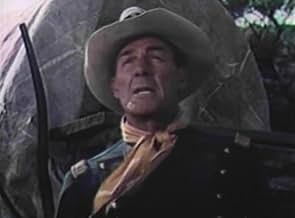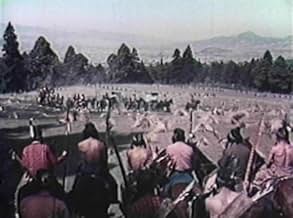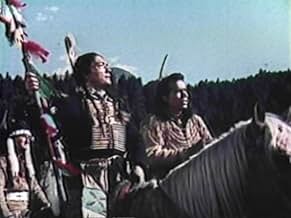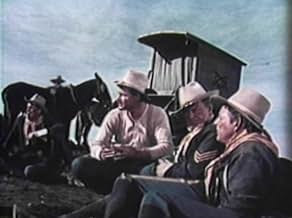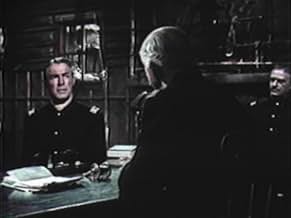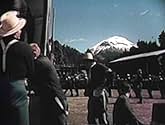CALIFICACIÓN DE IMDb
5.8/10
1.5 k
TU CALIFICACIÓN
Agrega una trama en tu idiomaAn officer accused of cowardice volunteers to bring back General Custers's body after Little Big Horn.An officer accused of cowardice volunteers to bring back General Custers's body after Little Big Horn.An officer accused of cowardice volunteers to bring back General Custers's body after Little Big Horn.
Bill Clark
- Soldier With Kellogg
- (sin créditos)
Charles Horvath
- Knife-Wielding Indian
- (sin créditos)
William Leslie
- Lt. Murray
- (sin créditos)
Harold Miller
- Officer at Inquiry
- (sin créditos)
- Dirección
- Guionistas
- Todo el elenco y el equipo
- Producción, taquilla y más en IMDbPro
Opinión destacada
Returning to Fort Lincoln, Captain Benson (Randolph Scott) learns of Custer's defeat at the Little Big Horn. Meanwhile, Benson carries his girlfriend ,Martha Kellogg (Barbara Hale), to the fort commanded by Col. Kellogg (Russell Hicks) who's Martha's father. Benson who was branded a coward for not taking part in the festivities attempts to assuage his guilt by heading up the burial detail, along with a group drunks and misfits (Leo Gordon, Denver Pyle, Harry Carey Jr, Frank Faylen) . At the inquiry as Custer's Officers blame Custer for the defeat, Benson tries to defend him. But Benson was suspiciously absent at the time of the battle and is now despised by the troops. So when an order to retrieve the bodies from the battlefield arrives, Benson volunteers for the dangerous mission of returning back into Indian territory. Charging the battle lines of the Sioux and the Cheyennes !. "Charge!"...See Randolph Scott avenge the massacre at Little Big Horn...and General Custer's Last Stand!
The film depicts a somewhat different look at Custer's defeat at the Little Big Horn, here an officer accused of cowardice volunteers to bring back General Custers's body after Little Big Horn. The muddled ending tries to tell us that the Indians were afraid of Custer's horse. One of Joseph H Lewis' two colour movies, a weird and occasionally enjoyable little Western focusing on the enmity between white and red man as Scott, accused of deserting Custer out of cowardice during the fiasco of Little Big Horn, sets out to discover the truth of the massacre. The film is acceptable and decent enough, being beautifully filmed and briskly paced. It's most interesting for a surprising anti-Custer stance, and for its surreal, almost supernatural event, which sees Custer's horse showing up like a ghost from the wilderness to allegedly bring peace between enemies. Stars Randolph Scott who gives a nice acting in his usual style as a cavalry officer accused of cowardice and is placed in charge of rebel soldiers detailed to bury the dead after the onslaught. In 7th Cavalry (1956) stands out a splendid plethora of secondaries at the time, such as: Jay C. Flippen, Frank Faylen, Jeanette Nolan, Leo Gordon, Denver Pyle, Harry Carey Jr. , Michael Pate, Pat Hogan, Russell Hicks, Frank Wilcox, Donald Curtis and Frank Hogan.
This Western is just a shade different thanks to Peter Parker's script and especially to the shooting of Joseph H Lewis, though nothing special. Professionally directed by Joseph H Lewis who chooses all the right angles for a real impact and never puts a wrong foot. He never really rose above the second feature, but turned in some fine work within the genre. During two decades, Lewis spent time at Columbia (1939-40, 1946-49), Universal again (1942), PRC (1944), MGM (1950, 1952-53) and United Artists (1957-58), reliably turning out a couple of pictures per year. While he helmed more than his fair share of horse operas, it was invariably his films noir which attracted the most attention. Lewis was a B craftsman who directed a lot of films of all kinds of genres with a penchant for Noir movies, as he made Drama, Thriller, Action, Western such as Terror in a Texas town, 7th cavalry, The Halliday brand, A lawless street, Cry of the hunted, Retreat hell, Desperate search , A lady without passport, The undercover man, So dark the night, My name is Julia Ross, The mad doctor of Market Street, The gang of mine and his greatest hits were The Big Combo and Gun Crazy . He spent a few more years directing episodic TV westerns (including several of the better episodes of The Rifleman (1958) and finally retired in 1966. Rating 6/10. Essential and indispensable watching for Western enthusiasts and Randolph Scott fans.
The film depicts a somewhat different look at Custer's defeat at the Little Big Horn, here an officer accused of cowardice volunteers to bring back General Custers's body after Little Big Horn. The muddled ending tries to tell us that the Indians were afraid of Custer's horse. One of Joseph H Lewis' two colour movies, a weird and occasionally enjoyable little Western focusing on the enmity between white and red man as Scott, accused of deserting Custer out of cowardice during the fiasco of Little Big Horn, sets out to discover the truth of the massacre. The film is acceptable and decent enough, being beautifully filmed and briskly paced. It's most interesting for a surprising anti-Custer stance, and for its surreal, almost supernatural event, which sees Custer's horse showing up like a ghost from the wilderness to allegedly bring peace between enemies. Stars Randolph Scott who gives a nice acting in his usual style as a cavalry officer accused of cowardice and is placed in charge of rebel soldiers detailed to bury the dead after the onslaught. In 7th Cavalry (1956) stands out a splendid plethora of secondaries at the time, such as: Jay C. Flippen, Frank Faylen, Jeanette Nolan, Leo Gordon, Denver Pyle, Harry Carey Jr. , Michael Pate, Pat Hogan, Russell Hicks, Frank Wilcox, Donald Curtis and Frank Hogan.
This Western is just a shade different thanks to Peter Parker's script and especially to the shooting of Joseph H Lewis, though nothing special. Professionally directed by Joseph H Lewis who chooses all the right angles for a real impact and never puts a wrong foot. He never really rose above the second feature, but turned in some fine work within the genre. During two decades, Lewis spent time at Columbia (1939-40, 1946-49), Universal again (1942), PRC (1944), MGM (1950, 1952-53) and United Artists (1957-58), reliably turning out a couple of pictures per year. While he helmed more than his fair share of horse operas, it was invariably his films noir which attracted the most attention. Lewis was a B craftsman who directed a lot of films of all kinds of genres with a penchant for Noir movies, as he made Drama, Thriller, Action, Western such as Terror in a Texas town, 7th cavalry, The Halliday brand, A lawless street, Cry of the hunted, Retreat hell, Desperate search , A lady without passport, The undercover man, So dark the night, My name is Julia Ross, The mad doctor of Market Street, The gang of mine and his greatest hits were The Big Combo and Gun Crazy . He spent a few more years directing episodic TV westerns (including several of the better episodes of The Rifleman (1958) and finally retired in 1966. Rating 6/10. Essential and indispensable watching for Western enthusiasts and Randolph Scott fans.
- ma-cortes
- 29 oct 2024
- Enlace permanente
Argumento
¿Sabías que…?
- TriviaThe saddle on Capt. Benson's horse is an early "plantation saddle." Officers, especially on the frontier, would often substitute personal equipment for military equipment based on taste and affordability.
- ErroresAs Corporal Morrison (Harry Carey Jr.) saddles "Dandy", Lt. Col. Custer's second mount, he puts on an English saddle. US Calvary adopted McClellan saddles which remained in service through World War II. This was the wrong saddle for the movie.
- Citas
[first lines]
Capt. Tom Benson: We'll be able to see the fort from the top of the next rise.
[Tom and Martha ride a little farther]
Capt. Tom Benson: There she is - Fort Lincoln, the base of the finest cavalry regiment in the country - and our home.
- Créditos curiososOpening credits: Capt. Benson was returning with his future bride, to his post commanded by the gallant Indian fighter Colonel Custer, who had prepared the famous 7th for all out war with the Sioux.
Selecciones populares
Inicia sesión para calificar y agrega a la lista de videos para obtener recomendaciones personalizadas
- How long is 7th Cavalry?Con tecnología de Alexa
Detalles
- Fecha de lanzamiento
- País de origen
- Idioma
- También se conoce como
- El fantasma de la batalla
- Locaciones de filmación
- Productoras
- Ver más créditos de la compañía en IMDbPro
- Tiempo de ejecución1 hora 15 minutos
- Relación de aspecto
- 1.85 : 1
Contribuir a esta página
Sugiere una edición o agrega el contenido que falta

Principales brechas de datos
By what name was 7th Cavalry (1956) officially released in India in English?
Responda



















